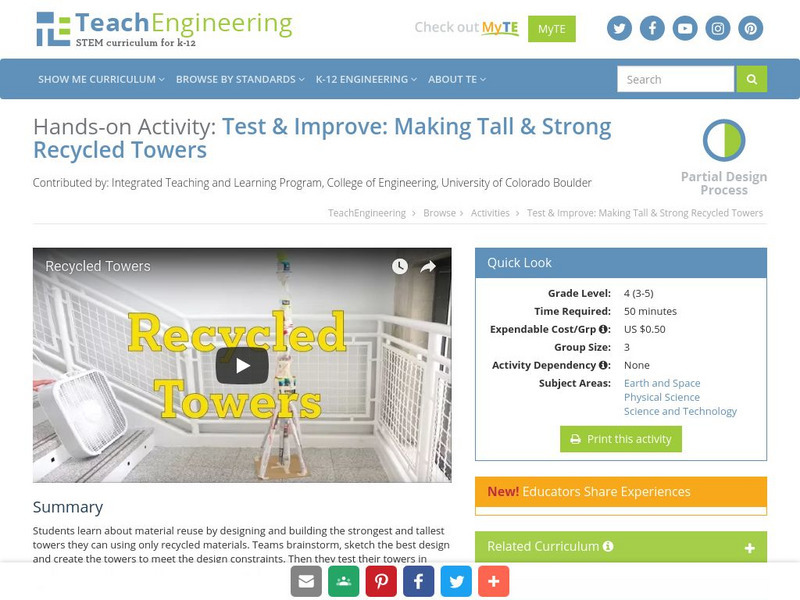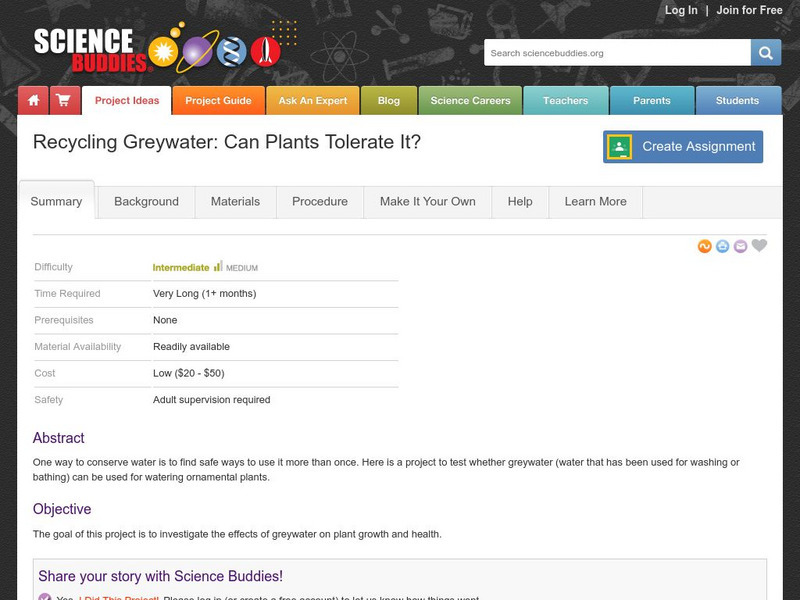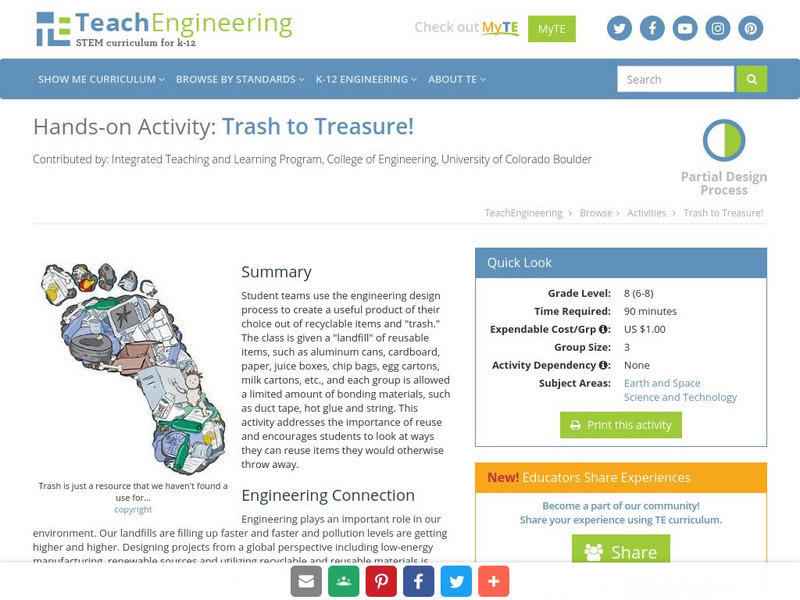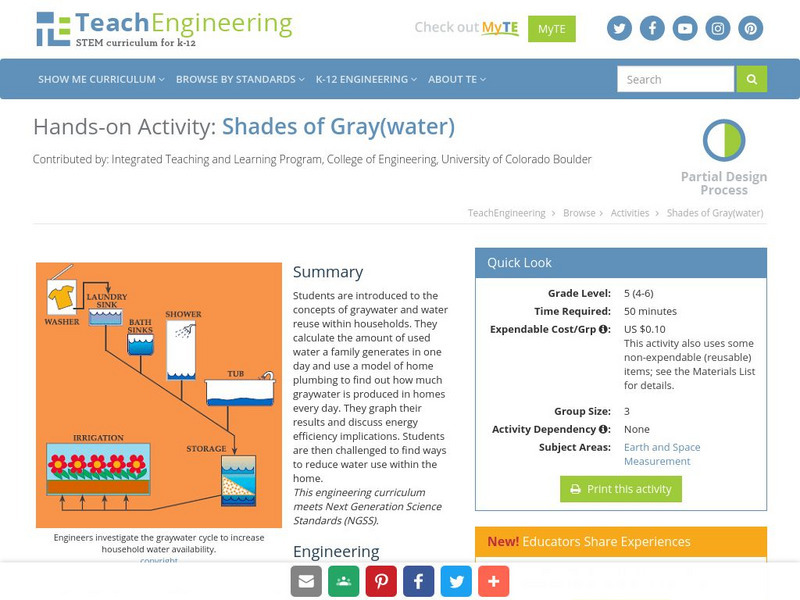Wild BC
Climate Change Bingo
Here is a 20-box bingo card to use when exploring ways that humans impact the environment. Various environmentally aware activities are listed in the boxes, and learners circulate the room to find someone who practices the different...
DiscoverE
Curious George Sailboat
A whole-group discussion kicks off a hands-on activity that challenges young engineers to build a sailboat using reusable materials. Participants gather recycled items to assemble their one-of-a-kind sailboat and test its ability to...
Environmental Protection Agency (EPA)
Happy Earth Day Coloring Book
From turning off lights when leaving a room, to biking or walking to school, there are many simple habits children can develop to help preserve the earth. Help raise environmental awareness in your class with this activity packet that...
Teach Engineering
Trash to Treasure!
One person's trash is another man's treasure. Challenge your class to build something useful out of the trash they throw away on a regular basis. Groups design and build a practical item from trash they collect, allowing the class to...
Forest Foundation
Waste Not - Want Not
Recycling is the focus in the sixth of a nine-lesson series devoted to forest ecosystems. Class members read an article about the responsible use of natural resources and ways to reduce land fill.
Seussville
What Can Your Class Do?
Inspire scholars to do their part for planet Earth with a read-aloud of Dr. Seuss's The Lorax, and variety of activities designed to boost the environmental activist in us all. Activities include writing poems about the Earth,...
Curated OER
Earth Day Snack Cup Project
Students plant a seed in a decorated left over yogurt cup. In this planting lesson plan, students reuse a yogurt cup that they would have thrown away, decorate it with wrapping paper, put dirt in it, and plant a seed.
PBS
Cloud Clues
It's cloudy with a good chance of learning! An inquiry-based lesson begins with an exploration of transparent, translucent, and opaque materials. Young scientists then connect their learning to the different cloud types as they take the...
PBS
Star Power
Let there be light—or maybe not. Pupils learn about light pollution with an investigation of constellations. They create constellation boxes and experiment with different levels of light. Observations are then made about the lighting in...
PBS
Twirling in the Breeze
Blow classes away with a hands-on lesson investigating wind speed. Learners use common materials to design and construct anemometers. They then test their anemometers and collect data on the wind speed created by a fan.
American Museum of Natural History
Make a Home for Microbes
Make a Winogradsky Column to discover how microbes live within the digestive tract. First, participants take a tour of the stomach. Then, gather supplies and start building using a variety of materials. Over eight to 10 weeks,...
Other
Siemens Science Day: Physical Science: Recycled Again!
Students will discover how to separate recycled goods by completing this hands-on science activity. Learn how physical properties are used to sort recyclable materials.
Environmental Education for Kids
Eek!: Wee Recyclers and Wee Crafts
A collection of educational materials - coloring pages, stories, games, lesson plans, activity sheets, etc. - for young children to learn how to recycle and why it is so important.
Read Works
Read Works: Recycling and Conservation Recycling: How It Works
[Free Registration/Login Required] An informational text about recycling and composting. A question sheet is available to help students build skills in reading comprehension.
PBS
Pbs Kids: Science Rockers: Recycling Paper
Easy recycling experiment through which recycle newspaper, by turning the used paper into pulp and then back to paper.
TeachEngineering
Teach Engineering: Recycled Towers
Students learn about material reuse by designing and building the strongest and tallest towers they can, using only recycled materials. They follow design constraints and build their towers to withstand earthquake and high wind simulations.
Science Buddies
Science Buddies: Recycling Greywater: Can Plants Tolerate It?
Water is a valuable resource many often take for granted. This exercise however gives you the opportunity to learn about and discover how greywater (water that has been used for washing or bathing) can be used for watering ornamental...
TeachEngineering
Teach Engineering: Trash to Treasure!
Student teams use the engineering design process to create a useful product of their choice out of recyclable items and "trash." The class is given a "landfill" of reusable items, such as aluminum cans, cardboard, paper, juice boxes,...
Smithsonian Institution
Lemelson Center: Spark!lab: Make a Yo Yo From Recycled Stuff
This activity explains how to use materials that might otherwise be recycled in order to create a yo-yo.
Read Works
Read Works: Too Much Trash
[Free Registration/Login Required] An informational text about recycling to reduce trash in landfills. A question sheet is available to help students build skills in reading comprehension.
NASA
Nasa: Climate Kids: Bag and Old T Shirt
Turn an old t-shirt into a reusable shopping bag for a trip the market, or even to the pool. Then, print the Climate Kids banner on the front and the Leaps and Flutters game on the back. Bring along a die, and find a couple of rocks or...
Other
Colts Neck Township Schools: Hands on Technology: Boxes, Bags and Bottles [Pdf]
Printable classroom-ready worksheets for tallying up and commenting on the waste, reusables, and recyclables associated with packed school lunches. (Reposted to CEED site)
Science Buddies
Science Buddies: Waste Not, Want Not: Use the Microbial Fuel Cell to Create Elec
Gross. What is that in the toilet? But maybe it's not just gross. Did you know there are bacteria that digest organic waste and create electrons? What if there was a way to collect those electrons to power a circuit? In this science fair...
TeachEngineering
Teach Engineering: Shades of Gray(water)
Students are introduced to the concepts of graywater and water reuse within households. They calculate the amount of used water a family generates in one day and use a model of home plumbing to find out how much graywater is produced in...




















